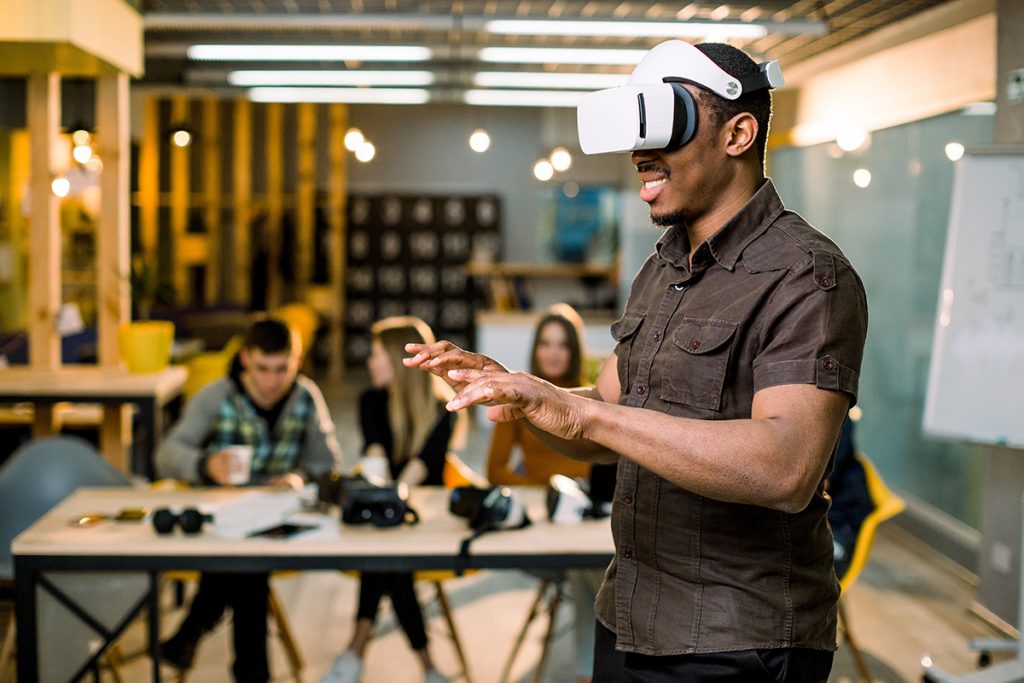
Stop us if you’ve heard this before: virtual reality (VR) is going to change the world! Since the early days of VR, technologists heralded it as the next major computing platform that captured our imaginations for its ability to substitute our physical reality and our sensory experiences. Little did we know that it would take a pandemic to help usher VR front and center as the next major computing platform. Some technology pundits claim that the upcoming war between Apple, Facebook, Google, and Microsoft will make the “battles we saw over smartphones seem like a minor skirmish.”
As massive investments pour into the VR field, improvements to hardware and software are inevitable. They will only help improve the way we interact with these experiences to the point that it becomes as natural as working with a smartphone. Consumers are already embracing VR, and the growth in the last year has been a testament to the fact that a significant market exists, with consumer surveys showing that VR headset owners are extremely engaged with their devices. As more and more of our potential learners engage with these tools in their personal and professional lives, we, in education, need to integrate these experiences in teaching and learning purposefully to stay current with required practices and skills in the marketplace.
The COVID-19 pandemic and the need for institutions to shift to remote learning accelerated VR adoption for teaching and learning now more than ever before. The platform’s potential is unquestionable, and it is already changing how we train surgeons and police officers, how we tell stories, and even how we treat chronic pain. Despite the tailwinds, it is essential to recognize that VR still has a long way to become ubiquitous.
What to Consider When Using VR for Teaching and Learning
We should consider its implications for teaching and learning, development costs, and accessibility constraints. We know that VR might enhance student learning, prepare them for real-world careers, bring students and teachers together regardless of location, and improve comprehension through direct interaction and engagement with learning objects, especially where highly complex problems require spatial understanding and visualization.
What makes VR compelling for teaching and learning are its two profound affordances: the feeling of presence and the agency associated with manipulating content. Combining the two produces unequivocally real experiences, thus making a compelling case for educators looking for opportunities to expose learners to experiences that are out of reach or impossible to replicate in a physical environment. In a virtual environment, learners get unlimited practice, manipulate time, perform high-stakes tasks without risking injury and death or physical damage. For example, as non-experts, medical students could perform serious surgery without the risk of injuring their digital patient nor running into ethics problems. Architecture students could use VR to improve how they create designs for their clients, immersing them in their space without actually building anything. The applications are endless.
Custom VR development can range from $5,000 to $300,000 and take anywhere from 3 to 24 months, depending on the project’s complexity. A good rule of thumb for estimating a VR project’s cost is to remember that cost is a function of the complexity and immersion level. Typically, an application with low immersion levels, such as a web browser experience paired with a 360-degree virtual tour, will be on the lower end of the cost. On the other hand, a multi-user experience that includes data visualizations, medical and surgical training, and enhanced collaboration will be on the higher end of the cost.
Fortunately, in the last few years, we see the emergence of no-code tools that enable interactive, immersive experiences without any special skills and require a software subscription, thus significantly reducing development costs. Platforms like Zoe, EngageVR, and the upcoming Microsoft Mesh allow for creating experiences using your digital assets, standard object libraries, add physics interactions, and even host multiplayer meetings without needing to hire a person with technical expertise in Unity, for example.
Addressing the Challenges of Access and Accessibility
Despite VR’s ability to broaden access to new worlds and experiences, our responsibility as educators is to make the industry aware of barriers to expanding educational institutions. Foremost, it is vital to recognize that some experiences remain inaccessible for learners with physical impairments. When designing these experiences, it is crucial to consider learners with impairments in mobility, hearing, cognition, low vision, blindness, and age. Keeping all end-users in mind, including diverse voices, and continuously considering and advocating for accessibility are a few things we can do to prioritize accessibility when designing VR experiences.
Once we can address the challenges of access and accessibility, VR is truly a universal and meaningful option for educators to revolutionize learning experiences across institutions and beyond.
Learn more about current initiatives and how you can take on a leadership role in VR (and the broader digital space) at your institution as part of OLC’s Institute for Emerging Leadership in Online Education (IELOL) hosted by Arizona State University.
Philippos Savvides is Associate Director of Learning Technologies at EdPlus at Arizona State University. He is curious about the interaction between technology and learning, and in his current role works toward creating solutions that enable access to education.
twitter.com/savvides
linkedin.com/in/savvides
In addition to being a proud IELOL ’19 alumni, Peter van Leusen is the Director for Learning Experience & Student Success for EdPlus, Design & Development, at Arizona State University. In this role, he seeks to form partnerships with academic departments, technology vendors, and other 3rd party organizations to make education accessible for all learners as well as ensuring meaningful learning experiences in diverse contexts.



